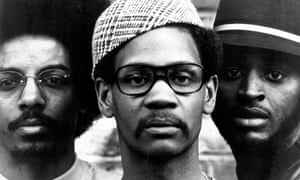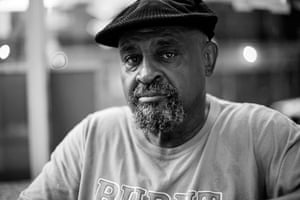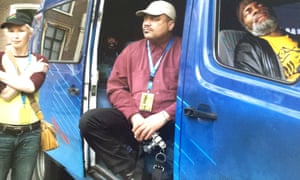The
Last Poets: America in poetry from black power to Black Lives Matter

“The Last Poets are the
microcosm of black America,” said Umar
Bin Hassan, one of the founding members of the group, when I first
met him in Harlem, New York, a decade ago. And he’s right: the turbulent and
sometimes violent history of this legendary group of African American men who
became famous worldwide in the late 1960s and early 70s with self-critical,
militant poems (“Niggers are scared of revolution. Niggers love anything but
themselves”) not only influenced generations of hip-hop and soul artists – such
as Public
Enemy, Ice
Cube, Ice-T,
2Pac,
Common,
Mos
Def and Erykah
Badu – but also the likes of David
Bowie and Mick
Jagger. Their fluent and funky conga-rhythms transformed poetry into
rap (a novelty at the time, though perhaps not today).
Umar Bin Hassan, now 68, is in a position to
reflect on their remarkable collective strength, resilience and hope. The Poets
always bounced back, no matter how much they struggled – and boy, did they
struggle. Umar, in particular, lived on the streets as a crack addict for years
and found success very hard to handle. Growing up in a ghetto, where he was
told “You ain’t shit” from a very young age, Umar worked as a shoeshine boy in
a red-light district to escape his father’s abuse. Racism, poverty and social
exclusion left their destructive marks on him; as Bin Hassan put it in one of
his autobiographical poems: “Self-hatred wrapped up in a twisted, demented but
well-controlled smile.”

From
the first moment I discovered the Last Poets – through my 11-year-old,
hip-hop-obsessed son – and from the first time I met them, I was completely
absorbed by their life stories and poetry, which continues to reflect today’s
black America.
The
Last Poets started out during the black power movement, in the
years, months and days after Martin Luther King, Robert F Kennedy and Malcolm X
had been murdered. They were young men living in the black ghettos of Akron,
Ohio, Detroit, Michigan, Jamaica Queens and The Bronx – all desperately seeking
a different life to that of their parents, who in their eyes were too subdued,
too damaged by racial oppression.
Inspired by the music of John Coltrane, the glamour
of the Temptations and the politics of black pride, they started performing on
street corners in Harlem where they immediately gained a following. But it
wasn’t until 1970, when Alan Douglas – the white record producer who made Jimi
Hendrix a star – convinced them to record their first album (Douglas drove into
the heart of Harlem in his silver Jaguar and appealed to them himself), that
they experienced fame. It became an instant classic. “White death will froth
the walls of museums and churches breaking the lies that enslaved our mothers
when the revolution comes,” is recited on When
the Revolution Comes. “The Statue of Liberty is a prostitute,” is
shouted out, on New York, New York.
Their
poetry seemed stronger then themselves, visionary even. But despite their
self-awareness, their scope for self-criticism didn’t prevent them from getting
into trouble; Umar and Félipe Luciano (former leader of the Puertorican Black
Panthers, now a politician) got mixed up in drugs; Jalal Mansur Nuriddin became a hustler; and
Abiodun Oyewole was in prison by the time the first Last Poets album came out,
and heard other inmates sing words he wrote from other cells.
When they were all together, they almost killed
each other fighting over rights and money. It was all too much for some: the
original founder of the Last Poets, David Nelson, retreated to his sisters’
house; fellow original member Gylan Kain moved to Europe. By the late 1970s,
their popularity had declined. Their disintegration coincided with the downfall
of the black consciousness movement in America; the FBI’s Cointelpro programme
had infiltrated all the major black political organisations, the Black Panther
party was in disarray and drugs were flooding into black neighbourhoods.
But the Last Poets were saved by their art. When
young hip-hop bands such as A Tribe Called Quest started sampling the Last
Poets’ words in their own raps in the early 1990s, Umar started writing poetry
again. After hearing his own voice on the radio, Umar went to Abiodun’s house
in Harlem and told him: “We still got something to say to the kids.” He started
reciting new work: “Arrogance is the demon that will kill us, before the white
men, before the drive-bys...”
It was the start of a new beginning. Umar and
Abiodun began working together again, recording new albums, and collaborating
with artists such as Common, Erykah Badu, and bands like Dead Prez. And they
found peace. Since then, despite all their internal fights, they have performed
together on stage at various points; wiser, a bit sadder perhaps, but no less
inspiring or militant.

Writing
a book about the Last Poets changed my life, not only as a person but as an
author. After spending months in America with these audacious artists who were
so far ahead of their time, I felt I could do anything as a writer, even making
music with words, just like the Last Poets themselves. Artistically, they
taught me to be completely free. And more broadly, they remain so relevant:
race remains one of the most urgent matters of our time. Not only in America,
where a new generation is fighting racism and police violence, but also in
Europe, where xenophobia and racism have become more open, more common.
Ultimately, the story of the Last Poets is about human resilience and beauty’s
sustaining power. I remember Umar telling me: “You have to turn yourself inside
out, until something raw and honest comes to the surface. Something unique, not
like anything else.” I definitely had to turn myself inside out. And I am glad
I did.
The Last Poets by Christine Otten, translated from
the Dutch by Jonathan Reeder, is published by World Editions (£12.99).




No comments:
Post a Comment